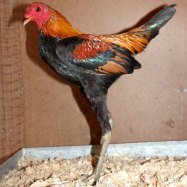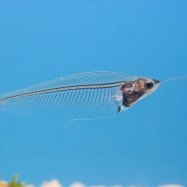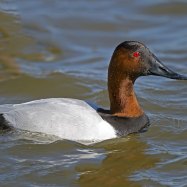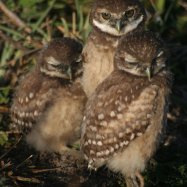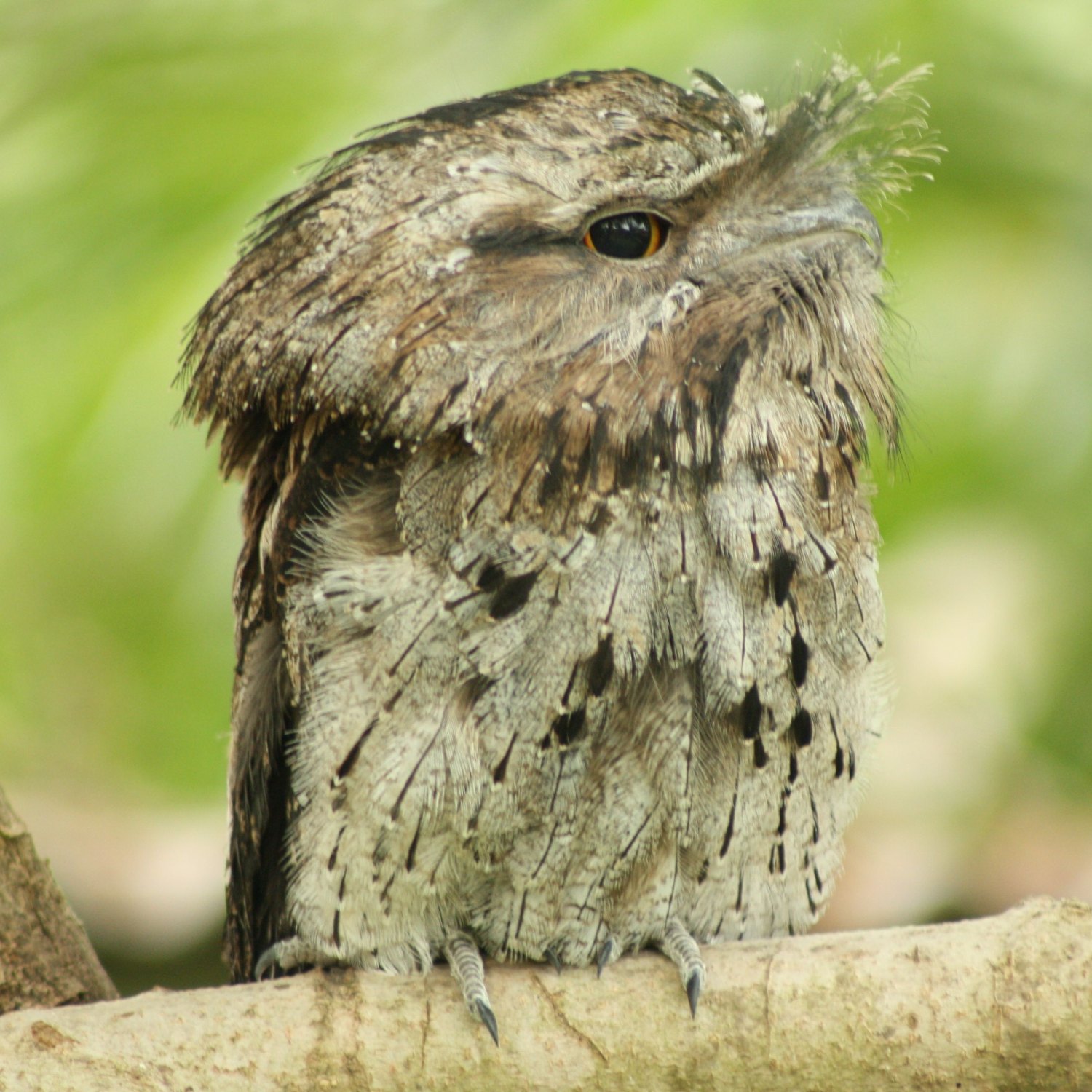
Tawny Frogmouth
33 to 53 cm (13 to 21 in)
The Tawny Frogmouth is a fascinating animal found in eastern and southern parts of Australia. With a length of 33 to 53 cm, it belongs to the Podargidae family and has a stocky and compact body shape. Despite its owl-like appearance, it's actually a bird species known for its large, wide beak and nocturnal habits. Keep an eye out for this unique creature on your next visit to Australia.
Animal Details Summary:
Common Name: Tawny Frogmouth
Kingdom: Animalia
Habitat: Woodlands, forests, and urban areas
The Fascinating Tawny Frogmouth: An Australian Nocturnal Hunter
When you think of a bird, the image that often comes to mind is a colorful, brightly plumage creature that soars effortlessly through the skies. But there is one bird that defies this stereotype with its unassuming appearance and impressive hunting abilities – the Tawny Frogmouth.Scientifically known as Podargus strigoides, the tawny frogmouth is a unique and fascinating bird that inhabits the eastern and southern regions of Australia. Its name derives from its large, wide and flat beak that resembles a frog's mouth, and its tawny coloring, making it easily blend in with its surroundings Tawny Frogmouth.
This nocturnal hunter belongs to the Caprimulgiformes order, which translates to "goat-suckers". However, contrary to its name, the tawny frogmouth doesn't actually suck goats. In fact, it doesn't suck anything but prey insects, and it doesn't do it during the day.
Let's take a closer look at this intriguing bird, its distinctive features, and its impressive skills that have evolved out of necessity.
A Unique and Diverse Habitat
The tawny frogmouth is a widespread bird, found in various regions of Australia, Tasmania, New Guinea, and Indonesia. It is particularly common in mainland Australia, where it inhabits woodlands, forests, and urban areas.In Australia, the tawny frogmouth is found in all states and territories, except for the Northern Territory. It favors open eucalypt woodland habitats, thick undergrowth, and areas with access to water. They are also commonly spotted in urban areas, such as parks and residential gardens Turkey Vulture.
Their wide distribution and adaptability to different habitats have made the tawny frogmouth one of the most abundant nocturnal birds in Australia.
Predatory Skills: A Cloak of Camouflage and Impressive Hunting Techniques
The tawny frogmouth is a true master of disguise. Its mottled gray, brown, and black plumage with intricate patterns helps it blend seamlessly with the bark of trees, acting as a camouflage against potential predators. Additionally, its stocky and compact body shape provides it with an advantage in maneuvering through the tree branches.But its unique appearance and ability to blend in with the environment are just the beginning of its impressive skills. As a nocturnal hunter, the tawny frogmouth is extremely efficient in spotting and capturing its prey in the dark.
Unlike other birds, the tawny frogmouth doesn't have strong talons to hunt. Instead, it relies on its sharp beak, which opens wide to capture flying insects and is surrounded by special bristles that act like a net, trapping insects when the bird swoops in.
Apart from its exceptional hunting technique, the tawny frogmouth also boasts impressive visual acuity and exceptional hearing. Its large, forward-facing eyes allow it to see in low light, while its sensitive hearing helps it locate potential prey in the dark.
A Family of Loyal and Monogamous Birds
Tawny frogmouths are not just exceptional hunters, but they also have remarkable family values. They are fiercely loyal and form monogamous pairs that remain together for life, enduring even harsh conditions.During mating season, they participate in intricate courtship rituals, where they face each other, puff up their feathers and make soft calls to each other. These rituals reinforce their bond and help strengthen their pair-bond.
Once paired, they work together to build a nest made of twigs and line it with leaves, feathers, and fur. Both parents take part in incubating the eggs and raising the young, who hatch after approximately 30 days.
A Protected Species
Even though the tawny frogmouth is a common bird in Australia, it is protected by law, thanks to its unique and fragile ecosystem. Any attempt to harm or relocate the bird without proper authorization from the authorities is strictly prohibited.The Australian government has also classified the tawny frogmouth as a vulnerable species due to habitat destruction and fragmentation, predation by feral cats and foxes, and roadkill incidents.
Conservation Efforts and Citizen Science
To help protect and conserve the tawny frogmouth, various conservation efforts are in place in different parts of Australia, such as habitat restoration and community education programs. Citizen science initiatives have also been established, calling on the public to report any sightings of the bird and its behavior to help gather data and monitor the species' population.These efforts have proven to be effective, with reports indicating a stable tawny frogmouth population in many parts of Australia.
Discovering and Appreciating the Tawny Frogmouth in its Natural Habitat
If you want to catch a glimpse of these impressive and elusive birds, the best time to do so is at dusk or dawn. As nocturnal hunters, tawny frogmouths are most active during these hours, flying silently and swiftly through the night in search of their next meal.You can also visit wildlife parks, nature reserves, and zoos that have tawny frogmouths in captivity to observe and learn more about them.
Be sure not to disturb the birds or their habitat, as any interference can cause significant stress and harm to these fascinating creatures.
In Conclusion
The tawny frogmouth is undoubtedly a remarkable bird – a master of disguise, an impressive hunter, and a loyal life partner. Its unique appearance, behaviors, and skills make it an animal worth learning about and appreciating.Its widespread distribution and adaptability to different habitats are a testament to its ability to survive and thrive in a constantly changing environment. However, as with many other animals, the tawny frogmouth faces threats to its population, making conservation efforts crucial to its survival.
So, the next time you're out in the evening, take a moment to appreciate the beauty and resilience of the tawny frogmouth, a true Australian icon.

Tawny Frogmouth
Animal Details Tawny Frogmouth - Scientific Name: Podargus strigoides
- Category: Animals T
- Scientific Name: Podargus strigoides
- Common Name: Tawny Frogmouth
- Kingdom: Animalia
- Phylum: Chordata
- Class: Aves
- Order: Caprimulgiformes
- Family: Podargidae
- Habitat: Woodlands, forests, and urban areas
- Feeding Method: Nocturnal, insectivorous hunters
- Geographical Distribution: Australia, Tasmania, New Guinea, and Indonesia
- Country of Origin: Australia
- Location: Eastern and southern parts of Australia
- Animal Coloration: Mottled gray, brown, and black plumage
- Body Shape: Stocky and compact
- Length: 33 to 53 cm (13 to 21 in)
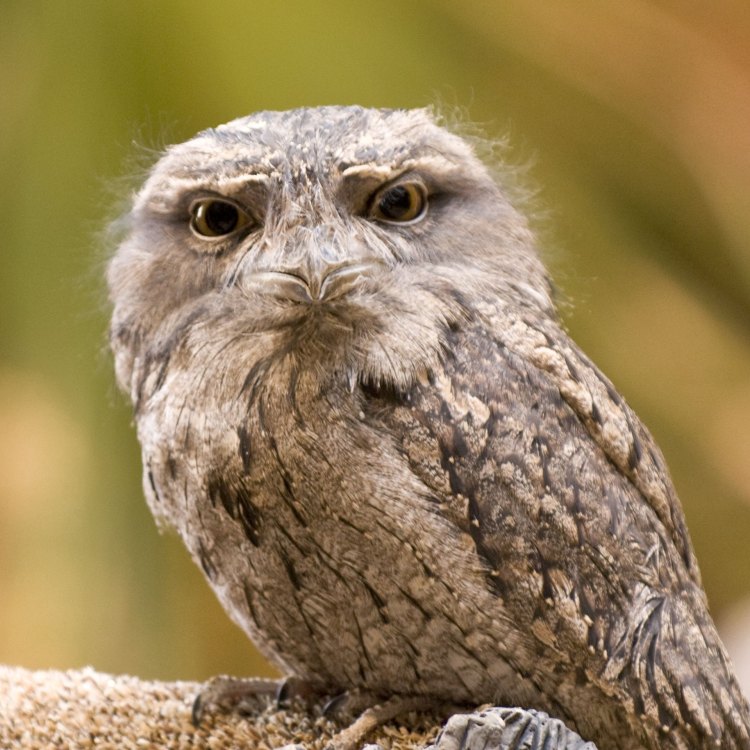
Tawny Frogmouth
- Adult Size: Medium-sized bird
- Average Lifespan: 10 to 15 years in the wild
- Reproduction: Monogamous
- Reproductive Behavior: Males and females share nesting duties
- Sound or Call: Low, booming calls resembling a frog
- Migration Pattern: Mostly sedentary, some local movements
- Social Groups: Pairs or small family groups
- Behavior: Camouflages itself during the day by perching upright and blending into tree branches
- Threats: Habitat loss, urbanization, and collisions with cars
- Conservation Status: Least Concern
- Impact on Ecosystem: Key predators of nocturnal insects
- Human Use: Not used by humans
- Distinctive Features: Wide beak, large yellow eyes, and feather tufts on the head
- Interesting Facts: They are often mistaken for owls due to their similar appearance
- Predator: Snakes, foxes, and large birds
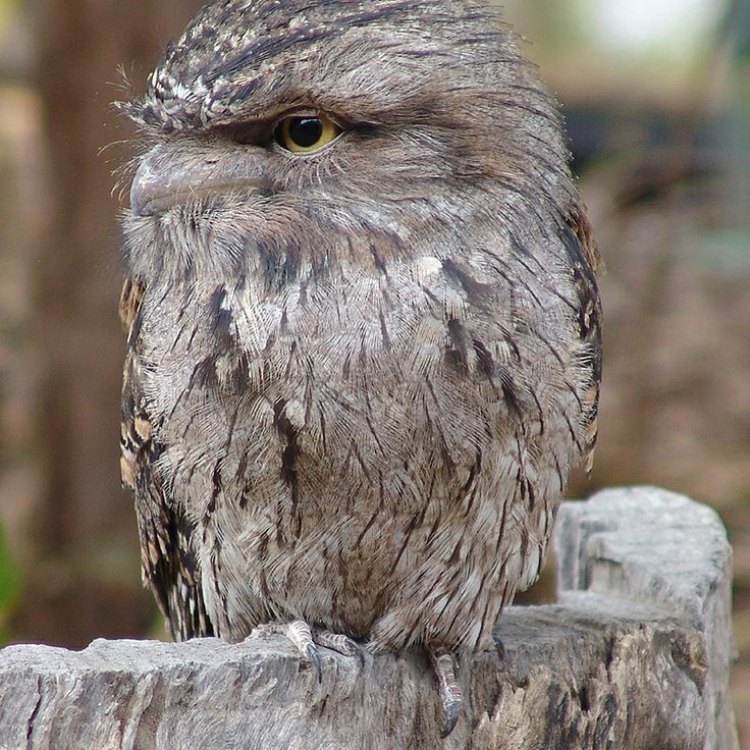
Podargus strigoides
The Fascinating World of Tawny Frogmouths: Australia's Masters of Camouflage
In the vast and diverse world of birds, there are some species that stand out for their unique traits and survival skills. One such bird is the Tawny Frogmouth, native to Australia, known for its distinctive appearance and fascinating behaviors. Don't be fooled by its name, as this bird is not related to frogs at all. In fact, it belongs to the family Podargidae, which means "rusty throat" in Greek PeaceOfAnimals.Com. In this article, we will delve into the world of Tawny Frogmouths and discover what makes them so special.The Basics: Size, Lifespan, and Reproduction
The Tawny Frogmouth is a medium-sized bird, measuring about 35-50 cm in length and weighing around 350-500 grams. They have a wingspan of 65-80 cm, making them efficient and graceful fliers. As for their lifespan, in the wild, these birds can live up to 10-15 years, while in captivity, they can live for up to 25 years.Tawny Frogmouths are monogamous birds, meaning they have only one mate for life. They form strong bonds with their partners and can stay together for many years. Mating season usually occurs between August and December, and during this time, the birds engage in distinctive courtship displays. Once the pair mates, they stay together to raise their young.
Reproduction Behavior: Sharing the Duties
One of the most unique and interesting behaviors of Tawny Frogmouths is their shared nesting duties Teddy Guinea Pig. Unlike most birds, where the female is responsible for incubating the eggs and caring for the young, Tawny Frogmouth males also take part in these duties. The female lays two to three eggs in the nest, and both the male and female take turns to incubate them for about 25 days. Once the chicks hatch, both parents feed and care for them until they are ready to leave the nest.Sounds and Calls: Booming and Frog-like
Tawny Frogmouths are nocturnal birds, meaning they are active and hunt during the night. However, they also make calls during the day, which can be heard mostly in the early morning or evening. These calls are low, booming sounds that resemble a frog, hence their name. These calls are primarily used for communication between pairs and family groups, and they can be heard up to 500 meters away.Migration Pattern: Mostly Sedentary with Some Local Movements
Tawny Frogmouths are mostly sedentary birds, meaning they do not migrate to other areas. They stay in their territories all year round, usually within a 1 to 2 km radius. However, some birds may make local movements within their territory to search for food and suitable nesting sites.Social Groups: Pairs or Small Family Groups
Tawny Frogmouths are solitary birds and maintain a small territory for themselves and their mate. However, during the breeding season, they form small family groups, consisting of the parents and their offspring. These family groups stay together until the young are old enough to establish their own territories.Behavior: Master of Camouflage
One of the most remarkable features of Tawny Frogmouths is their ability to camouflage themselves. These birds are experts at blending into their surroundings, making them nearly invisible during the daytime. They do this by perching upright on tree branches, closing their eyes, and remaining still for long periods. Their grayish-brown plumage and feather tufts on their head resemble a broken tree branch, making them difficult to spot. This behavior helps them avoid detection by predators and also aids in hunting their prey.Threats: Habitat Loss and Collisions with Cars
Like many other animal species, Tawny Frogmouths also face threats to their survival. The biggest threat to their population is habitat loss due to urbanization and deforestation. As these birds have adapted to live in specific habitats, any destruction of their homes can have a significant impact on their population. Another prevalent threat is collisions with cars, as these birds are active during the night, making them vulnerable to being hit while flying across roads.Conservation Status: Least Concern
According to the International Union for Conservation of Nature (IUCN), Tawny Frogmouths are currently classified as least concern. However, their populations are declining in some areas due to habitat loss and other threats. Conservation efforts are ongoing to protect these birds and their habitats, such as creating wildlife corridors and preserving woodland areas.Impact on Ecosystem: Key Predators of Nocturnal Insects
Tawny Frogmouths play an essential role in their ecosystem as key predators of nocturnal insects. These birds have a varied diet, consisting mainly of moths, beetles, and other insects. By feeding on these insects, they help to control their populations, maintaining the balance of the ecosystem.Human Use: Not Used by Humans
Unlike many other bird species, Tawny Frogmouths are not used by humans for any purposes. They are not hunted for their feathers or meat, nor are they kept as pets. Instead, they are left to roam freely and play their role in the ecosystem.Distinctive Features: Wide Beak, Large Yellow Eyes, and Feather Tufts
Tawny Frogmouths are easily recognizable by their distinctive features. They have a wide, hooked beak that they use to catch and eat their prey. Their large yellow eyes allow them to see well in the dark and aid in their hunting at night. And of course, their most unique feature is the feather tufts on their head, giving them their distinct look.Interesting Facts: Mistaken for Owls
Tawny Frogmouths are often mistaken for owls due to their similar appearance. However, they are not related to owls, but they do share some common traits, such as their camouflage behavior and hunting at night. Their resemblance to owls is a result of convergent evolution, where two unrelated species evolve similar characteristics in response to similar environmental conditions.Predators: Snakes, Foxes, and Large Birds
Despite their remarkable camouflage skills, Tawny Frogmouths still have some natural predators. Snakes, foxes, and large birds, such as crows and kookaburras, may prey on these birds and their eggs. However, their camouflage behavior and strong parental care help in reducing their vulnerability to predators.In Conclusion
In a world full of unique and fascinating bird species, the Tawny Frogmouth stands out for its distinctive features, behaviors, and survival skills. From its shared nesting duties to its mastery of camouflage, these birds have captured the interest and admiration of bird enthusiasts around the world. As we continue to learn more about these birds, it is essential to protect their habitats and ensure their survival for generations to come.
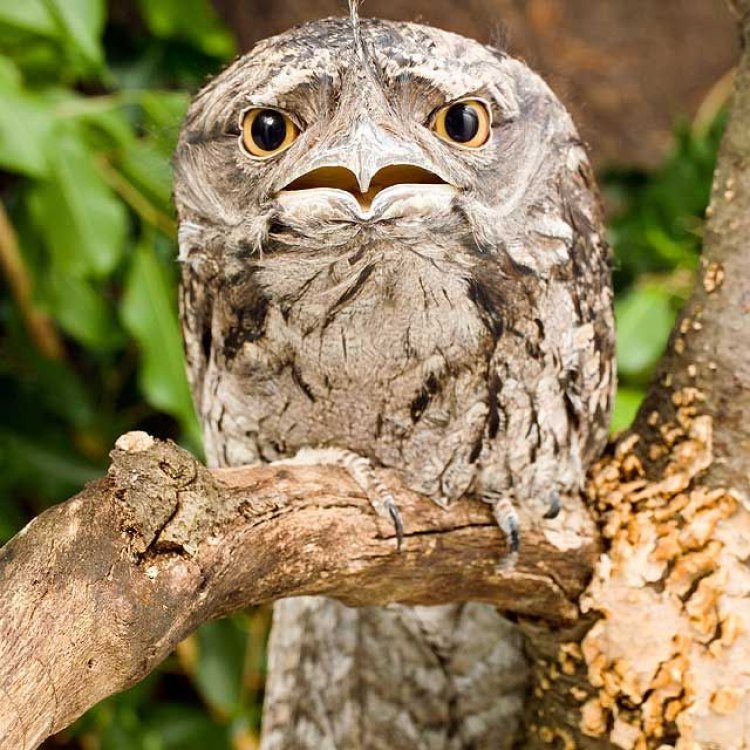
The Fascinating Tawny Frogmouth: An Australian Nocturnal Hunter
Disclaimer: The content provided is for informational purposes only. We cannot guarantee the accuracy of the information on this page 100%. All information provided here may change without prior notice.







